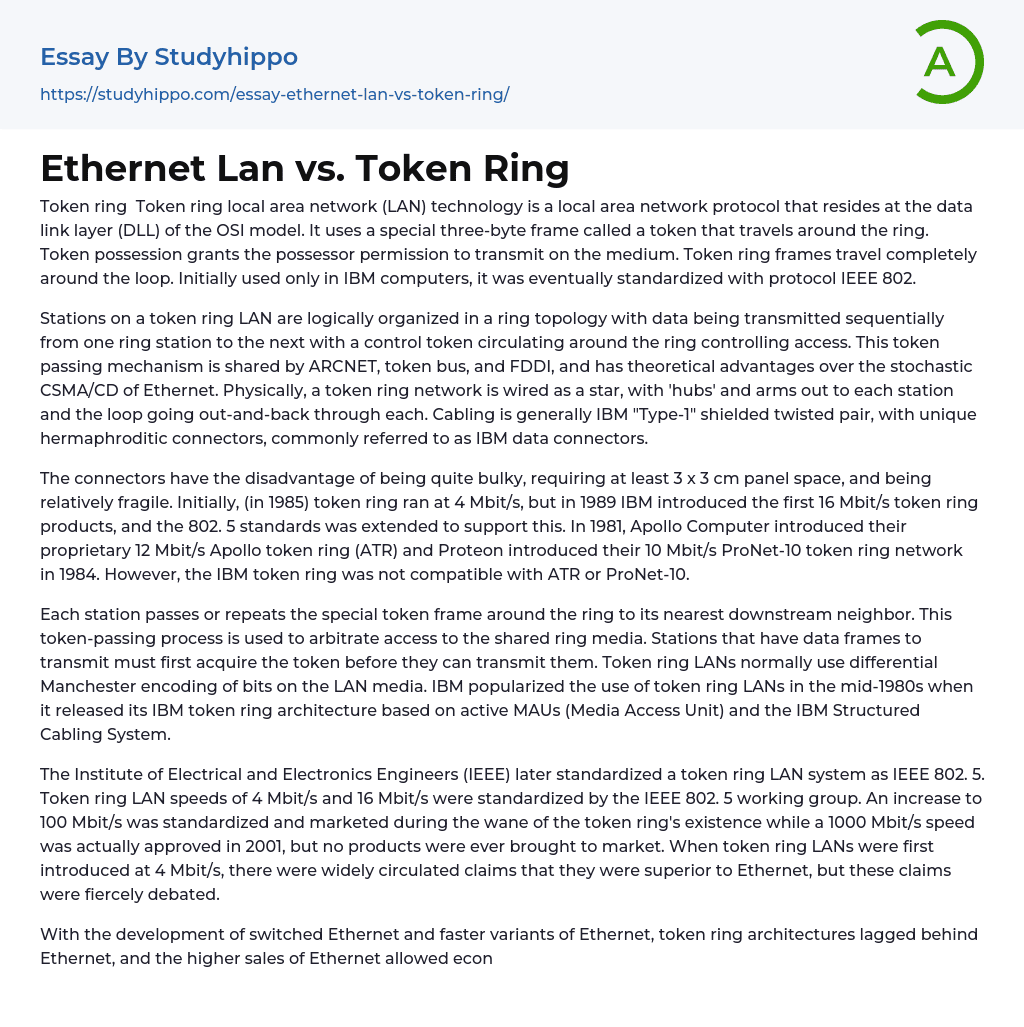Token ring Token ring local area network (LAN) technology is a local area network protocol that resides at the data link layer (DLL) of the OSI model. It uses a special three-byte frame called a token that travels around the ring. Token possession grants the possessor permission to transmit on the medium. Token ring frames travel completely around the loop. Initially used only in IBM computers, it was eventually standardized with protocol IEEE 802.
Stations on a token ring LAN are logically organized in a ring topology with data being transmitted sequentially from one ring station to the next with a control token circulating around the ring controlling access. This token passing mechanism is shared by ARCNET, token bus, and FDDI, and has theoretical advantages over the stochastic CSMA/CD of Ethernet. Physically, a token ring network is wire
...d as a star, with 'hubs' and arms out to each station and the loop going out-and-back through each. Cabling is generally IBM "Type-1" shielded twisted pair, with unique hermaphroditic connectors, commonly referred to as IBM data connectors.
The connectors have the disadvantage of being quite bulky, requiring at least 3 x 3 cm panel space, and being relatively fragile. Initially, (in 1985) token ring ran at 4 Mbit/s, but in 1989 IBM introduced the first 16 Mbit/s token ring products, and the 802. 5 standards was extended to support this. In 1981, Apollo Computer introduced their proprietary 12 Mbit/s Apollo token ring (ATR) and Proteon introduced their 10 Mbit/s ProNet-10 token ring network in 1984. However, the IBM token ring was not compatible with ATR or ProNet-10.
Each station passes or repeats the special token frame around the ring to
its nearest downstream neighbor. This token-passing process is used to arbitrate access to the shared ring media. Stations that have data frames to transmit must first acquire the token before they can transmit them. Token ring LANs normally use differential Manchester encoding of bits on the LAN media. IBM popularized the use of token ring LANs in the mid-1980s when it released its IBM token ring architecture based on active MAUs (Media Access Unit) and the IBM Structured Cabling System.
The Institute of Electrical and Electronics Engineers (IEEE) later standardized a token ring LAN system as IEEE 802. 5. Token ring LAN speeds of 4 Mbit/s and 16 Mbit/s were standardized by the IEEE 802. 5 working group. An increase to 100 Mbit/s was standardized and marketed during the wane of the token ring's existence while a 1000 Mbit/s speed was actually approved in 2001, but no products were ever brought to market. When token ring LANs were first introduced at 4 Mbit/s, there were widely circulated claims that they were superior to Ethernet, but these claims were fiercely debated.
With the development of switched Ethernet and faster variants of Ethernet, token ring architectures lagged behind Ethernet, and the higher sales of Ethernet allowed economies of scale which drove down prices further and added a compelling price advantage. Token ring networks have since declined in usage and the standards activity has since come to a standstill as 100Mbps switched Ethernet has dominated the LAN/layer 2 networking market Ethernet
Ethernet is a family of computer networking technologies for local area networks (LANs) commercially introduced in 1980. Standardized in IEEE 802. 3, Ethernet has largely replaced competing wired LAN technologies.
Systems communicating over Ethernet divide a stream of data into individual packets called frames. Each frame contains the source and destination addresses and error-checking data so that damaged data can be detected and re-transmitted. The standards define several wiring and signaling variants.
The original 10BASE5 Ethernet used a coaxial cable as a shared medium. Later the coaxial cables were replaced by twisted pair and fiber optic links in conjunction with hubs or switches. Data rates were periodically increased from the original 10 megabits per second, to 100 gigabits per second. Since its commercial release, Ethernet has retained a good degree of compatibility. Features such as the 48-bit MAC address and Ethernet frame format have influenced other networking protocols.
- Smartphone essays
- Cell Phones essays
- Camera essays
- Computer essays
- Ipod essays
- Mobile Phones essays
- 3g essays
- Bluetooth essays
- Cell Phones in School essays
- Computer File essays
- Desktop Computer essays
- Servers essays
- Telecommunication essays
- Network Topology essays
- Telecommunications essays
- Cloud Computing essays
- Computer Science essays
- Consumer Electronics essays
- Data Analysis essays
- Electronics essays
- engineering essays
- Enterprise Technology essays
- Hardware essays
- Impact of Technology essays
- Information Age essays
- Information Technology essays
- Modern Technology essays
- Operating Systems essays
- people search essays
- Robot essays
- Networking essays




